The Welsh town of Hay-on-Wye is the prototype for the book town movement. Just as Glastonbury found in music the perfect town brand, so the small town of Hay created a new identity through second-hand books. In Hay, the recycling of words has become an all-consuming industry with the yearround business of book sales augmented by the annual Hay Festival of Literature & the Arts which in late May and early June pulls the literary crowd (and their hangers-on) to town.
Richard Booth was the son of a motorcycle mechanic who went to Oxford. Unlike his peers who progressed to careers in London and other big cities, Booth returned to the small town where he was born and worked hard to put Hay on the map. With a deep disdain for capitalism, and an appreciation of the importance of using local assets, Booth’s pioneering efforts transformed Hay-on-Wye.
Communities across Europe have espoused the Hay model with varying degrees of success. There have been two intersecting sets of interests which have bred an entire network of book towns.


